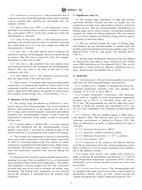We need your consent to use the individual data so that you can see information about your interests, among other things. Click "OK" to give your consent.
ASTM D7213-14
Standard Test Method for Boiling Range Distribution of Petroleum Distillates in the Boiling Range from 100 °C to 615 °C by Gas Chromatography
STANDARD published on 1.10.2014
The information about the standard:
Designation standards: ASTM D7213-14
Note: WITHDRAWN
Publication date standards: 1.10.2014
SKU: NS-37886
The number of pages: 16
Approximate weight : 48 g (0.11 lbs)
Country: American technical standard
Category: Technical standards ASTM
Annotation of standard text ASTM D7213-14 :
Keywords:
boiling range distribution, distillation, gas chromatography, petroleum, simulated distillation,, ICS Number Code 75.080 (Petroleum products in general)
Additional information
| Significance and Use | ||||||||||||||||||||||
|
5.1 The boiling range distribution of light and medium petroleum distillate fractions provides an insight into the composition of feed stocks and products related to petroleum refining process, This gas chromatographic determination of boiling range can be used to replace conventional distillation methods for control of refining operations. This test method can be used for product specification testing with the mutual agreement of interested parties. 5.2 This test method extends the scope of boiling range determination by gas chromatography to include light and medium petroleum distillate fractions beyond the scope of Test Method D2887 (538 °C) and below Test Method D6352 (700 °C). 5.3 Boiling range distributions obtained by this test method are theoretically equivalent to those obtained by true boiling point (TBP) distillation (see Test Method D2892). They are not equivalent to results from low efficiency distillation such as those obtained with Test Method D86 or D1160. |
||||||||||||||||||||||
| 1. Scope | ||||||||||||||||||||||
|
1.1 This test method covers the determination of the boiling range distribution of petroleum products. This test method is applicable to petroleum distillates having an initial boiling point greater than 100 °C and a final boiling point less than 615 °C at atmospheric pressure as measured by this test method. 1.2 The test method is not applicable for analysis of petroleum distillates containing low molecular weight components (for example, naphthas, reformates, gasolines, crude oils). Materials containing heterogeneous components (for example, alcohols, ethers, acids or esters) or residue are not to be analyzed by this test method. See Test Methods D7096, D2887, D6352, or D7169. 1.3 This test method uses the principles of simulated distillation methodology. 1.4 The values stated in SI units are to be regarded as standard. No other units of measurement are included in this standard. 1.5 This standard does not purport to address all of the safety concerns, if any, associated with its use. It is the responsibility of the user of this standard to establish appropriate safety and health practices and determine the applicability of regulatory limitations prior to use. |
||||||||||||||||||||||
| 2. Referenced Documents | ||||||||||||||||||||||
|
We recommend:
Technical standards updating
Do you want to make sure you use only the valid technical standards?
We can offer you a solution which will provide you a monthly overview concerning the updating of standards which you use.
Would you like to know more? Look at this page.




 Cookies
Cookies
